The Royal Navy say that ships leaving Faslane on the Clyde faced swarms of attacks from fast boats.
Royal Navy warships negotiating the confined waters of the Clyde on their way to the Joint Warrior exercise practiced with their gunnery teams to fight off massed assaults by fast-moving speed boats.

The Royal Navy said in a statement:
“It’s precisely the sort of attack ships fear – lots of attackers, confined and congested waters – and practise regularly for; gunnery training focuses on this ‘asymmetric threat’, including using laser targeting to improve accuracy against fast-moving, zig-zagging, erratic foes.
Portsmouth minehunter HMS Hurworth followed by frigate HMS Sutherland, based in Plymouth, were first out of Faslane to run the gauntlet as the pair headed for the Cumbrae Gap.”
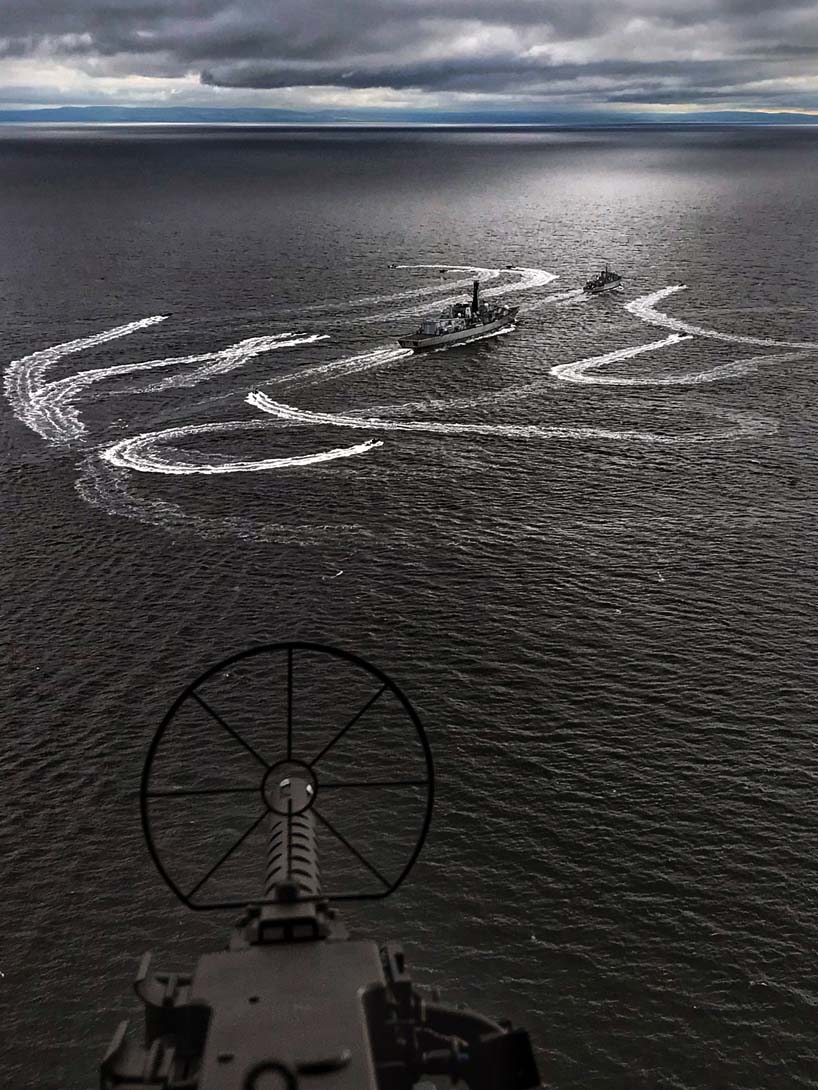
Warning messages were broadcast over the radio, but when these were ignored, the onus fell on the ship’s protection teams on both ships to fend off the swarms using machine-guns and Mini-guns (hand-held Gatling guns), with Sutherland also able to weigh in with her 30mm automatic cannon, say the Royal Navy.
The Royal Navy added that ‘swarmex’ was the first test of Joint Warrior 19-2 for the participating naval forces.
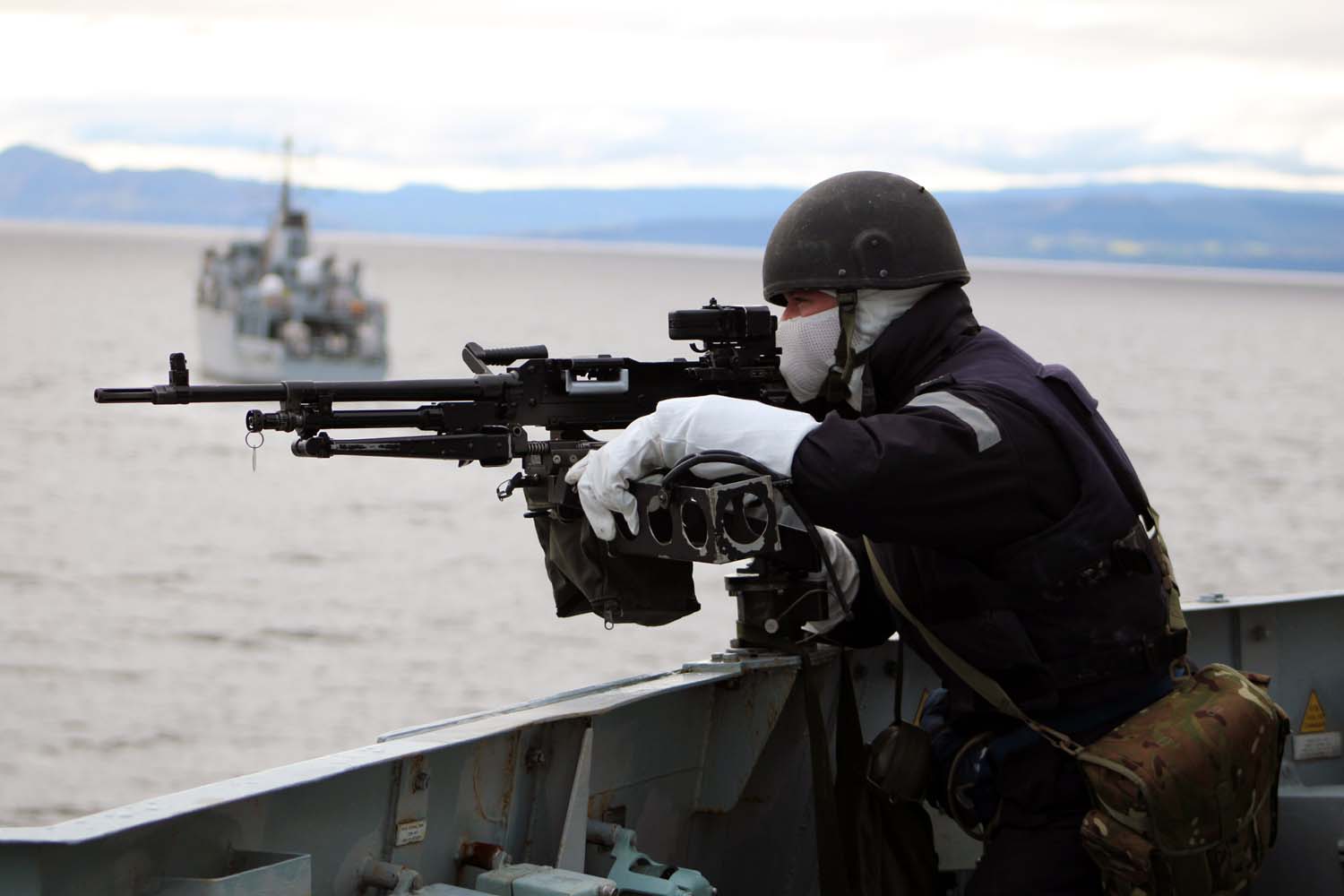
Run in the spring and autumn, Exercise Joint Warrior – directed from Clyde naval base – tests the ability of British and allied air, sea and land forces to work together.


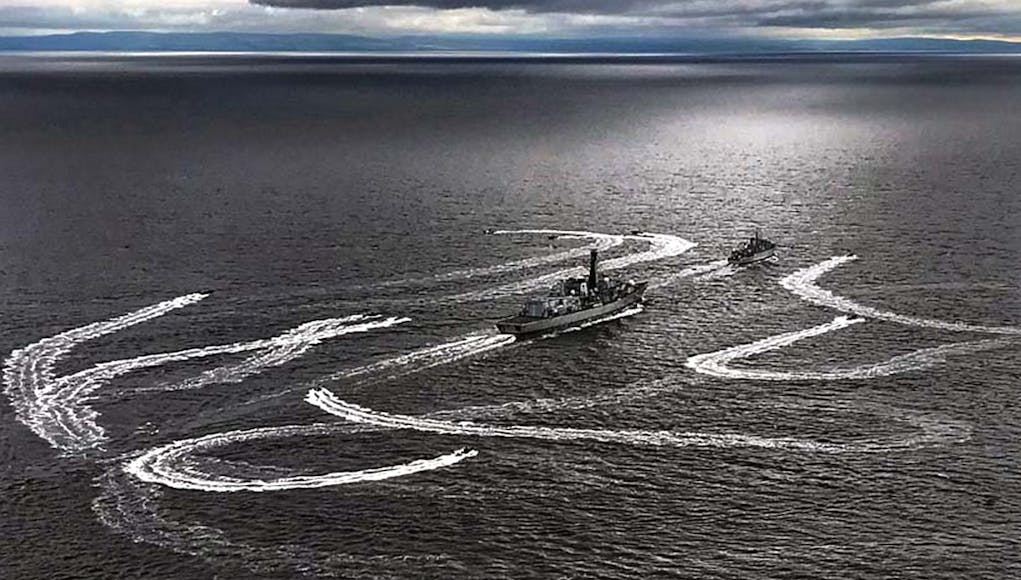

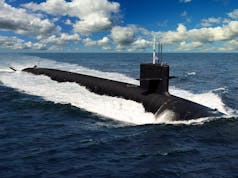



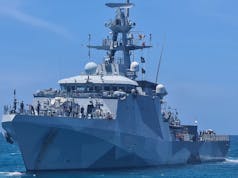





Fast boats and drone swarms pose the greatest threat to warships today. The conventional envelop of engagement (over the horizon) is much established, but close in attack in confined waters is another situation entirely. The Gulf poses a risk of such an attack that could render onboard weapons useless in a protracted action, especially if the target vessel is patroling alone? The way forward has to be weapon/radar development that can handle sustained swarm attacks. In WW2 the Japanese Kamarzi strategy enveloped US navy vessels and the only real option was to fit multiple guns, to create a wall of lead. Maybe multiple Pralanx systems (average of four per vessel) is the short term solution?
Weve been here before, see the Jeune École.
French late 19th century naval doctrine adopted by many other nations that swarms of light cruisers and torpedo boats would make larger capital ships obsolete. The Doctrine itself was made obsolete by increasing warship defences such as torpedo bulges and the lack of seaworthiness of these smaller boats meaning they were unable to project power beyond the coast.
Well, a swarm attack by boats would only work in the first minute of a conflict. After that, any small boats approaching a significant combatant ship would be destroyed at longer range by aircraft. Whoever anticipated that and contemplated the light missiles due to be integrated with wildcat deserves to go to the top of the class.
RN vessels have multiple guns.
Multiple Phalanx are not needed and the practicalities of fitting , maintaining and supporting such an endeavour is a non starter on oh so many levels.
The RN has practised defence against small boat attacks for decades. It is not something new.
I doubt the word Boghammer rings many bells but these where used by Iran in the 1980s and where the wake up call for small boat attacks. Any ship doing Portland/GUZ FOST workups then and still now, does a restricted channel exit from the harbour where the ship comes under small boat and aircraft attack in restricted waterway ( A mine cleared channel)
A current RN FF/DG has a number of options.
1. Up revs and disappear at 30+ knots ducking and weaving. No small boat will survive a wake hit. They will flip or founder.
2. Shoot at them. 4.5 Gun at 20 rns per min air bursting will cause an immense amount of damage. Most people only see the flash and smoke when a round goes off. Looking via a Thermal Imager you get to see the 4000 + pieces of shrapnel flying out in a 150m diameter circle at over 700m/s
3. 30mm chain guns. Thermal image and laser range finder controlled + the upcoming addition of on mount Martlet. 3-6 rounds of HEIT will stop a boat.
4. 50 Cals shooting 1 or 4 Bit at 500rnds per min
5. 7.62 MiniGuns shooting 1 and 4 bit at 3000 rnd per min
6. GPMGS shooting 1 or 4 bit at 600 rnds per min.
Chances are the helo will be up and it will be joining in with a 50 cal and soon martlet.
Drones- you have 2 options go kinetic or go electronic. Electronic is far easier. If you jam and uplink/ down link the drone is not going to work. We are years away from a credible AI powered drone threat and once it does arrive the electronics are still susceptible to disruption via other means.
A good perspective on the issue. I’m still not convinced the risk of the fast boats has been fully realised, and many warships patrol alone and can’t always be assured of air support. If certain countries continue the practice of fast and numerous attack by small craft, then in time these will become heavily armoured, (possibly reactive?) and capable of withstanding considerable incoming fire. Recent footage on U-Tube has demonstrated just how much small arms damage they can endure, and by big caliber weapons too! Worse still, the development of sub drones to work simultaneously with the aforementioned, could possibly overload onboard defence systems? I don’t accept the argument phalanx is a nonstarter, if anything, it should be a priority to multi-fit to any vessel exposed to regions where swarm attack is possible.
I know we’ve practised against swarm attacks (using blanks!), but has there ever been a live fire exercise against remotely controlled craft? To actually see if a ship can be protected against say a large attack of small fast boats. I know how difficult it is to manually hit a seaborne moving target, whilst on a ship that’s bobbing up and down, especially if you haven’t got a stabilised weapon system (hence the reason for 4 bit).
Looking at those mini guns and the mention of 30mm I’m left wondering how much more effective 40mm would be assuming there was space. If transiting a confined area where ranges are much lower maybe not so much but in more open water e.g. shore-launched attack with the target ship standing a few miles off shore?
With T31 now looking to adopt 40mm instead of what I suppose many of us expected to be DS30 cross-decked from T23 does anyone think it slightly incongruous that T26 let alone the carriers or Albion/Bulwark have lesser close-in systems than T31 when looking just at that particular system (i.e. admitting that T31 has to make up for not having Phalanx)? Perhaps for T26 weight/stability might be an issue since it mounts its 30mm cannons to port and starboard as opposed to T31 centre-line 40mm mounting but T26 is a big ship so I suspect the presumably fairly modest extra weight might not be an issue and surely for QEC and LPD it wouldn’t be an issue at all.
With the 40mm soon entering service with T31 hence all logistics already coming in how much would it cost to upgrade the DS30s on T26, the carriers & the LPDs to 40mm and would that be worthwhile? It does seem so incongruous to me for T31 to be better armed than so much bigger and more expensive ships when looking particularly at that tier of the defensive layers.
I suspect that on smaller ships and/or less sophisticated ships it might not be such a significant gain since the existing radars might not be sophisticated enough to take full advantage of the 40mm especially when engaging air targets (e.g. River, Hunt, Sandown, various RFA vessels etc) but for the big Artisan-equipped ships?
I think part of the answer can be found in that the T31 is a GP frigate; every weapon system has to pull double duty (except for Sea Ceptor, unless they have a land attack capability that I’m unaware of?). So the 57 mm and 40 mm guns have to be able to most capably handle surface and air targets, as well as potentially a land target if the T31 is operating in the littorals. It’s the only explanation I can think of that justifies bringing new calibre weapons systems into the RN.
As to why the RN think that the DS30 is sufficient for T23s, T26s and T45s, probably a mix of them being a legacy fit, and that they aren’t really expected to be working in the littorals much, where the small boat swarm is the big threat.
I’m just guessing though, the RN doesn’t generally like to share their thinking on these things. Personally, I’m still a fan of introducing a navalised CT40 with the new Martlet clip on- if we’re going to bring something new in at all. Probably a bit too left of field though!
Loads of martlets too.
A mix of Martlets and Starstreaks I think would be great. I think there’s a good case for a RAM type launcher that contains a mix of both Martlets and Starstreak. Martlet has during trials shown that it can down not only helicopter drones but also fixed wing drones like the Qinetiq Banshee which travels up to 650mph at sea level. Therefore it could a tiered approach to defence with Martlet provide defence against small fast boats, subsonic aircraft/drones, then switch to Starstreak for the supersonic stuff.
I’m not sure if the CTA40 can increase its rate of fire of 180 – 200 rounds per minute (rpm). The BAe/Bofors 40mm L70 has a higher rate of fire of 240 – 330 rpm. The ability to put lots of rounds down range quickly is essential, but in today’s fight, using guided rounds I suppose can mitigate the slower rate of fire. The super40 uses a much larger cartridge than the standard 40, this gives a range advantage over the CTA40. However, the CTA40 cartridges only use 60% of the available volume for propellant leaving the last 40% for plastic guides to hold the round. If solid propellant was used instead, the range would be comparable to the Super40’s.
The CTA40 breech is very compact and the side feeder is inline with the pinion axis so makes for a fixed and direct feed mechanism. However, delivering rounds to the breech is quite complex and has been the cause of a number of stoppages. I believe a more robust system is now in place, as I’ve heard of very few if any issues with stoppages lately. It would make a lot of sense if the Army and Navy could collaborate on the gun and ammo. This would help drop the cost of the ammo quite significantly.
Something else just struck me and I don’t know why I didn’t think of it before but with your (DaveyB’s) comment it just hit me in the face due to your radar expertise.
I commented about how I found it incongruous that T31 might, at least as far as cannons are concerned, be better armed than various so much bigger and more expensive ships but even more perplexing to me is that the T31 radar choice, especially if it does turn out to be Thales NS200 as opposed to NS100, would give the RN’s T31s, £250m cost-optimised frigates, a significantly better main radar (as I think you yourself have said Davey) than the Artisan 997 on the T26, the carriers and the LPDs. This just doesn’t make sense to me.
I think the Artisan was part of the original T26 contract, so we are probably tied into it for a while. I’d not be surprised if BAe start making noise about a cheaper version of Sampson. They have already had a version working with flat panel arrays. So there’s still scope for development. Wait and see I suppose.
The NS200 by all accounts is a very capable radar. Personally think its a step up from Artisan, but it could be improved further by mounting a second array in a back to back arrangement like Sampson.
The choice of the 40mm L70 is curious, if indeed that’s where T31 is going, but I can see some rationale (although would it not make sense to adopt the CTA 40mm for commonality? Probably too expensive). If the alternative was two DS30s, then no CIWS anti-missile capability, or alternatively one DS30 and one Phalanx would not ensure 360 degree protection from fast boats (although the 57mm could fill the gap forward, surely?). Two Bofors 40mm mounts provide both 360 degree anti-air/missile/UAS CIWS (although not as effective as Phalanx) and good protection against fast boats – and in a swarming scenario three guns are better than one or two. Although DS30 with Martlet would have more range and punch than 40mm alone, perhaps? Yet there are enough beam gun positions on T31 to have DS30 there too, and one or two Phalanx in the B and C positions would provide high end protection. Since the 40mm mounts are not deck penetrating, I imagine Phalanx or future directed energy or electromagnetic weapons could be shipped as the mission requires. Phalanx is currently fitted on a mission by mission basis anyway.
Presumably 40mm L70 and Martlet/Starstreak aren’t mutually exclusive. With the launcher already demonstrated on a DS30 mount I wouldn’t have thought there would be any show-stopper issues with doing the same on a 40mm mount except for time, budget and political will to actually fund such an initiative of course.
For the RN T31 maybe it is a bit more complicated though because the DS30 used for the RN Martlet work was on an “open” mount (for want of a better word) whereas the T31 renders that we’re seeing are showing the 40mm in cupolas presumably for stealth (although maybe not?) in which case I assume that things become more difficult especially if there are stealth characteristics that need to be maintained.
One thing the Bofors 40mm seems to give vs the DS30 (and the CT40) is range which I assume in an anti-air role is extremely useful in terms of the altitude at which it could engage an aerial target.
Yes and a wider range of munitions – airburst and so on.
Both the onboard LMG and helo 50cal are utilising standard sights. On the face of it, adopting the EO on-mount sights offered for these weapons would appear to be a cost effective upgrade to such existing systems. Know the US trialled same on their helocopters but cannot ascertain if they were considered adequate at that stage of their development. Either way, such a system would seem well worth the effort for these multiple and fast moving threats.
The GPMG has a sight that projects a web over the target at infinity reducing eye strain. It also has a laser for illumination and is NVG compatible .
The M3 door gun is fine.
I have done the door gunner job in a Lynx . The sight gives you an indication of where to put the rounds.
In reality you actually watch and walk the tracer onto the target.
OK, cheers. Maybe this was what the US found – perhaps using a holographic sight, or similar.
Martlet should have been cleared for ship-launch by now? Anything with a 30mm Cannon should be armed with at least 7 cells/canisters per gun.
Why the delay?
The couple of machine guns on RN boats are mostly 7.62mm and a few .50 cal (12.7). Range effective ranges 800m to 1,800m. Most Iranian fast attack craft are armed with 14.5 heavy machine guns and 20mm cannon. Effective range 3000m to 6000m. You do the maths. And before the cry what about the RN 30mm? Well the Iranians may be stubborn as mules but they are not stupid. They know the arcs of fire and would avoid them. I have posted numerous time RN vessels are underarmed. Politicians are gambling with the lives of sailors to save a few pounds. Brimestone 11, Martlet or Spear 3 should be deployed on RN vessels as a matter of urgency.
Totally agree. And get Wildcat armed up ASAP. 50mm cannon not good enough.
know.The effective range of a 7.62 GPMG is 1800m, 7.62 Mini Gun is 2000m, 50 cal 2000m-2500m.
Its actually a lot more than a couple of machine gunson board but hey what do I know…
Effective range is getting rounds on target with accuracy.Try aiming a gun from a small boat in a swell doing 20+ knots at a moving target that is shooting back at you
You will hit sod all.
The effective range in a swell of a small boat is far less than that of a stable large ships weapon ranges.
Regarding firing arcs. its obviously a little known fact that the RN has a thing called overlapping arcs of fire and has this thing call a propulsion system that allows you to move the ship around to open up the firing arcs .
I know this because I spent over a third of a century as an RN Gun systems maintainer (hence the moniker) , operator and system engineer on everything from 7a 20mm, 4Omm Bofor, 20mm BMARC, Twin 30, Single 30 , AGS 30mm, Phalanx, Goalkeeper Oto 76mm and 4.5 Guns(Mk6 and Mk8). To that you could also add me being a qualified Armourer for every small arm from a 9mm pistol ,SMG , SLR, SA80, GPMG, Mini Gun ,50 Cal and a few other more exotic small arms that crossed my path. And lets not forget the missile and air weapons systems I also looked after.
RN Lynx, had in the old Gulf Mod versions , 2 x 50cal pods fitted and or a combination of Sea Skua regular and A variants (Ultra Low Level attack height for small boat attacks) . Until the Wildcat gets a decent Anti Ship missile this is a glaring deficiency but the M3 is an adequate system, not ideal but it is adequate.
Gunbuster. 1st. Swell in the Gulf for most of the year is almost nonexistent. Normal sea state in the Gulf is 1 to 2.With days of 0 to 1. Dec and Jan occasionally gets up to 3 or 4. 2nd. I was only quoting ranges from the internet. But your correction does not alter the fact that the Iranian 14.5mm and 20mm outrange the RN 7.62/12.5. 3rd. I did not want to bore people but many of the Iranian Fast Attack craft are armed with light missiles which have even greater range. 4th. There is no guarantee that a Wildcat would be available. HMS Montrose could not get its chopper up when the Stena Impero was seized. The Montrose was issuing warnings to the Iranians for over 1 hour. Warning issued in Persian, ” Please confirm that you are not intending to violate international law by unlawfully attempting to board the MV Stena.” The Iranians treated the warning with contempt. 5th. Arcs. 4 to 6 boats, approaching from fore or aft would overcome an RN vessel attempts to bring the 30mm to bear. 6th.The sea states are not from the internet but from experience in the Gulf. This experience includes being in Iranian choppers that enjoyed buzzing US carriers. It was normal that the chopper would only back off after the carrier gave a third and final warning that we would be shot down. Lastly do not overestimate the RN’s defences while underestimating the Iranians. It is almost inevitable that in any conflict a US or RN vessel would have to deal with numerous high speed boats many loaded up with explosives, heavy MG, torpedoes and rockets. They have reportedly 1500 fast attack craft. The most lethal being the SERAJ-1. Built by reverse engineering British technology. Armed with a various rockets and heavy machine gun. It is known to be highly stable and have a speed of between 72 and 85 knots. The Iranians have been preparing for years for this.
I am in the Gulf some 50m from the coast and get daily weather updates due to my job. Today is a lovely 36 deg with 1-3ft swell inshore rising to 5 off shore . From personal experience of being out on the lumpy stuff it is not a flat calm and benign environment for most of the year. Winter is bloody awful. Squalls, rain, snow and heavy seas which are not good in a small boat.
Ranges for a 14.5 are greater than a 50cal but the 14.5 mount is not stabilised. It is a nigh impossible task trying to aim a gun from a speed boat at near sea level doing 20+ knots at another moving target.
Light missiles are a threat but again the same issues apply. Aiming and keeping the missile on target unless you are close in is difficult. An RPG on a jet ski is a threat if you let it get close enough…so you dont let it get close.
Helicopters buzzing all warships in the Gulf is standard fare from all sides. The fact that they back down after 3 warnings shows that the ROE work. You issue warnings, step them up and if they are not heeded then you engage. From experience the IRG are the issue not the Iranian Navy. The IRG are the ones who push the envelope at all times. The Iranian Navy are a professional group who follow the rules and conventions when operating at sea.
Wildcats are available at either alert 5 or 15 post the Stena Incident.
As I said vessels always manoeuvre to open weapon arcs. It wont just be the 30mm shooting to P&S but also the other weapons which are Fwd, Aft and midships and the 4.5.
Super fast boats have limitations. IRG Boghammers have been known about for years and countermeasures are in place . A boat doing 70+ knots will be doing it in the flat calm in a straight line. Start turning, have to put up with a wake or some chop and that speed is going to come down very rapidly. I was recently on a (very!) fast USN boat that has stabilised weapon systems, TI sights and laser range finders. Even they struggle to hold a target at speed and in a chop.
Gunbuster. Well if you are happy with the defences I stand corrected.
“Swarmex”? Jesus Christ does the MoD have to put “ex” after everything to make up some new stupid phrase? Almost as infantile as “photoex”.
The USS Essex carrier, had 12 x 5 inch, 32 x 40mm, 46 x 20mm AA guns. But the Essex and other heavily armed carriers could not knock down the lone kamikazi attackers that had leaked thru the defensive ring of destroyers firing 100 ‘s of AA guns and CAP’s. Yet the RN boats are expected to fend of swarms of fast attack craft with their axis of attack exploiting blind spots, with a couple of GMP’s, Miniguns and 2 x30mm. The Essex had almost more guns alone than the entire RN fleet.